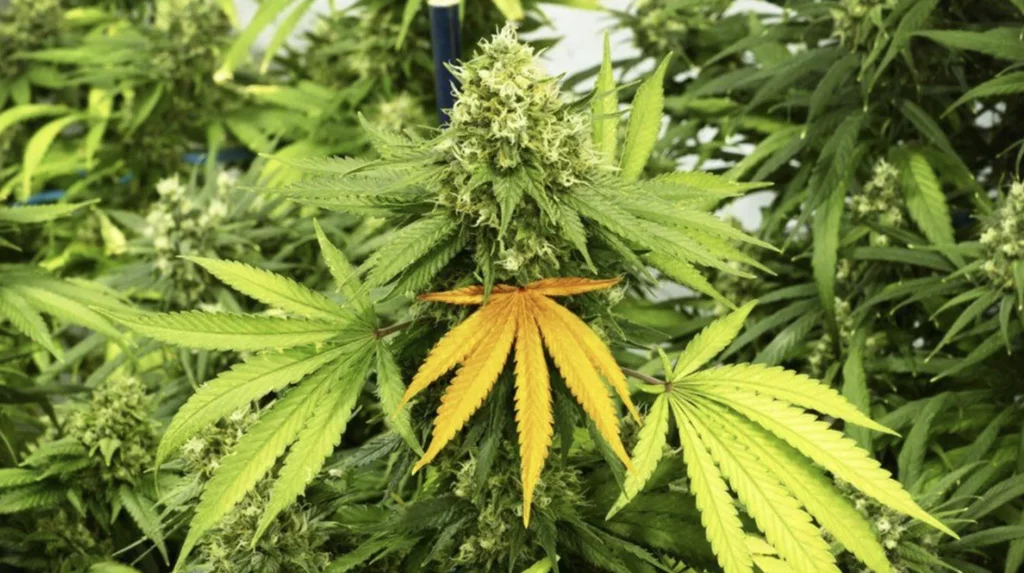Introduction
Cannabis cultivation can be a rewarding experience, but it comes with its share of challenges. One common issue that growers encounter is yellowing leaves, which can indicate various underlying problems. In this guide, we’ll explore the causes of cannabis leaves turning yellow and provide solutions to help you maintain healthy plants.
Causes of Yellowing Leaves

Yellowing leaves are a common concern among cannabis growers and can indicate underlying issues affecting plant health. Understanding the causes of yellowing leaves is essential for diagnosing and addressing problems promptly to ensure the continued growth and vitality of your plants.
Several factors can contribute to the yellowing of cannabis leaves, ranging from nutrient deficiencies and overwatering to pests and diseases. Nutrient deficiencies, such as nitrogen, magnesium, and iron, can result in distinct patterns of yellowing, providing valuable clues for diagnosis. Additionally, improper watering practices, such as overwatering leading to root rot or underwatering causing stress, can also lead to leaf yellowing.
Pests and diseases pose another threat to cannabis plants, with insects like spider mites and diseases like powdery mildew capable of causing significant damage and yellowing of leaves. Environmental factors such as pH imbalance, temperature fluctuations, and humidity levels can further exacerbate leaf yellowing.
In this guide, we will delve into the various causes of yellowing leaves in cannabis plants, providing insights into identifying and addressing these issues to promote healthy growth and optimal yields. Understanding the underlying factors contributing to leaf yellowing is the first step towards cultivating thriving cannabis crops.
1. Nutrient Deficiencies
- Nitrogen deficiency: Causes older leaves to turn yellow from the tips inward while leaving veins green.
- Magnesium deficiency: Leads to yellowing between leaf veins, known as interveinal chlorosis.
- Iron deficiency: Results in yellowing leaves with green veins, similar to magnesium deficiency but more pronounced.
2. Overwatering or Underwatering
- Overwatering can lead to root rot, inhibiting nutrient uptake and causing leaves to turn yellow and wilt.
- Underwatering deprives plants of essential moisture, leading to stress and yellowing leaves.
3. pH Imbalance
- Incorrect pH levels can affect nutrient absorption, leading to deficiencies and yellowing leaves.
4. Pests and Diseases
- Pests like spider mites, aphids, and thrips can damage leaves, causing them to yellow and curl.
- Diseases such as powdery mildew and root rot can also contribute to leaf yellowing.
Also Read: Cannabis Seed Storage: Tips for Long-Term Preservation
Solutions to Yellowing Leaves
Addressing yellowing leaves promptly is crucial for maintaining the health and vitality of cannabis plants and ensuring optimal growth and yields. While identifying the underlying causes of yellowing leaves is essential, implementing effective solutions is equally important for restoring plant health and promoting vigorous growth.
Fortunately, several strategies can help alleviate yellowing leaves and restore the overall health of cannabis plants. These solutions range from adjusting nutrient levels and optimizing watering practices to implementing pest management techniques and addressing environmental factors.
Proper nutrient management is paramount for addressing yellowing leaves caused by nutrient deficiencies. Adjusting fertilizer formulations and ensuring balanced nutrient uptake can help rectify deficiencies and promote healthy foliage development. Additionally, maintaining proper pH levels in the growing medium is crucial for optimizing nutrient availability and preventing nutrient imbalances.
Optimizing watering practices is another key aspect of mitigating yellowing leaves. Overwatering and underwatering can both contribute to leaf yellowing, highlighting the importance of maintaining adequate moisture levels and allowing the growing medium to dry out between waterings.
1. Adjust Nutrient Levels
- Use a balanced fertilizer to address nutrient deficiencies and maintain optimal nutrient levels.
- Monitor pH levels and adjust as needed to ensure proper nutrient uptake.
2. Proper Watering Practices
- Allow soil to dry out between waterings to prevent overwatering.
- Ensure adequate drainage to prevent waterlogged soil and root rot.
3. Pest and Disease Management
- Inspect plants regularly for signs of pests and diseases, and treat promptly if detected.
- Use organic pest control methods such as neem oil or insecticidal soap to manage pest infestations.
4. Environmental Conditions
- Maintain appropriate temperature and humidity levels in the grow area to promote healthy plant growth.
- Provide adequate airflow and ventilation to prevent humidity-related issues like mold and mildew.
Conclusion
Yellowing leaves can be a sign of various issues affecting cannabis plants, including nutrient deficiencies, watering issues, pests, and diseases. By identifying the underlying cause and implementing appropriate solutions, growers can address yellowing leaves and promote the overall health and vitality of their cannabis plants. With proper care and attention, you can minimize leaf yellowing and cultivate thriving cannabis crops.

